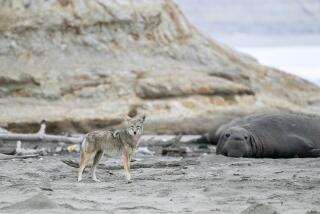Seal Tissue Samples Frozen for Future Pollution Study
- Share via
GAITHERSBURG, Md. — By freezing tissue samples from seals, researchers today hope to help scientists of tomorrow understand the effects of Alaskan oil drilling on the environment.
Scientists at the National Institute of Standards and Technology are now collecting samples from seals, and plan to gather tissue samples from walruses, bears and sea otters to determine the effects of pollutants from oil drilling on the ecosystem. The samples are taken from seals hunted and used for food by local people.
“It’s like the studies on freezing the human body,” said Stephen Wise, a researcher for NIST, which will be storing the frozen samples. “We are saving the animal samples for the future, when technology will be advanced further.”
Some of the seal samples are being gathered on the Alaskan North Slope, an oil drilling site, which is also a winter refuge of fur seals. Scientists will use flesh from two seal species in different locations in Alaska for the research project.
Minus-300 Degrees
The NIST will study the samples, then store them at minus-300 degrees in liquid nitrogen to be used one or two decades from now, Wise said. The extreme temperature prevents any contamination or loss of toxic chemicals from air. This temperature also stops all biological processes that may break down genetic material of the cells.
Funded by the Mineral Management Service of the Department of Interior, the ongoing study will enable future scientists to test for pollutants that have not been discovered, but may be detectable in coming years, said Paul Becker, a biologist with the National Oceanic and Atmospheric Administration in Anchorage, Alaska.
Once samples are collected, they will be frozen in sterilized containers, then sent to be stored at NIST headquarters in Gaithersburg.
The tissue samples will be studied for toxic trace elements, pesticides, and PCBs (polychlorinated biphenyls)--a cancer-causing liquid oil contaminant--before being frozen.
By selecting different species of seals, scientists gain a broader picture of pollution problems in Alaska. “We’re picking species from the Arctic, Beria, and Chukchi (Sea) area so we can integrate a large area for the study,” said Carol Anne Manen, a colleague of Becker.
“We want to see if contamination decreases or increases and (if there is) a biomagnification tion effect in the food chain,” she said.
Biomagnification of chemicals begins when small creatures, low in the food chain store a contaminant in their bodies. As consecutively larger predators eat many of their smaller, contaminated prey, they show higher and higher levels of the chemical in their flesh. In this case, the seals eat fish, which may have traces of PCBs, and the level builds up within the food chain, she said.
Becker said all the countries bordering Arctic regions, including the United States, Canada and the Soviet Union, were contributing to the pollution through coastal mining, off-shore drilling and air pollution.
Bruce Batten, spokesman for the U.S. Fish and Wildlife Service in Anchorage, noted, “PCB is even found in Barrow, the nation’s northernmost town in Alaska. Eskimos have been living and hunting in that town for 4,000 years.
“This is a world-wide problem. In the Arctic we have a thing called acid snow. Pollutants all the way from Europe cause contamination,” he said, adding that the levels so far have not been high enough to cause damage in Alaska.
A virus, which has sometimes been called “seal AIDS,” has already wiped out 70% of the harbor seals in Northern Europe. Contrary to popular belief, the mass deaths were not caused by environmental pollution--although pollution probably weakened the seals’ resistance to the disease, said Mats Olsson, head of the Swedish research team that isolated the virus.
More to Read
Sign up for Essential California
The most important California stories and recommendations in your inbox every morning.
You may occasionally receive promotional content from the Los Angeles Times.













